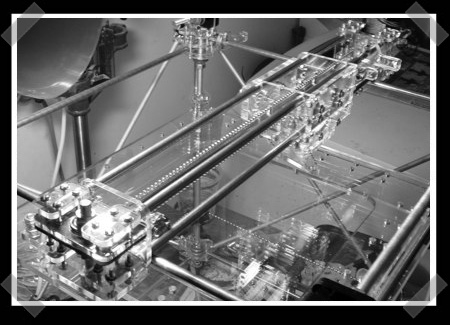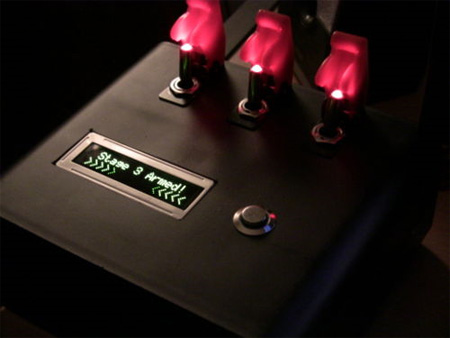The RepRap is a self-copying 3D printer. The project has published plans for creating a lasercut acrylic version of the device. They call it a RepStrap since once assembled it could produce printed plastic versions of the machine components, bootstrapping true RepRaps. The plans are available for Ponoko an on-demand product service, and it would cost ~$380 if you used their service. The plans are free, so you could get them manufactured by other means. [vik] is still putting together the assembly instructions. He hopes to have an all inclusive electronics kit at some point too. This is another great step towards putting desktop manufacturing within reach of everyone.
Misc Hacks4186 Articles
Arduino Duemilanove

The latest generation of Arduino hardware has been released. The Arduino Duemilanove (2009 in Italian) has the same form factor as previous generations. The specs are essentially identical to the Diecimila, but there have been a few changes to the hardware. The power source is no longer chosen using a jumper. A MOSFET and dual OPAMP have been added to the board to automatically selected between USB power and the external plug. Automatic hardware resets are optional now. Next to the USB port are two solder pads labeled RESET-EN. Cut the trace between them to kill the reset. If you ever want it back, just bridge the pads. The hardware was updated to correspond with the release of Arduino cofounder [Massimo Banzi]’s new book.
Jar Of Fireflies

[Randomskk] has been attempting to make electronic fireflies for quite some time and finally settled on a design he liked. His jar of fireflies uses an ATtiny13 to control a set of 12 matrixed LEDs. The green SMD LEDs are each soldered to a pair of thin wires that hang down into the jar. The software picks an LED at random to flash and then flashes it 1-3 times. The random seed is incremented each time the jar is turned on, so you’ll get 255 different patterns. The power is just a standard coin cell. The project is fairly simple electrically, but the LED soldering could prove difficult. It was inspired by this firefly jar project. Check out [Alex]’s synchronizing fireflies too. A video of the jar is available below. Continue reading “Jar Of Fireflies”
Tiny Arduino Ethernet Board

[sgk] built this tiny ethernet board to be used with the Arduino. It’s based on a WIZnet W5100 chip. The chip handles all of the TCP/IP communication and you talk to it via SPI. It’s compatible with the standard Arduino ethernet library. [sgk] hand soldered these boards including the 80pin LQFP main chip. His next project is to put the AVR and W5100 all on the same board. It sounds like he’ll use components larger than 1005 though.
DIY RFID Implant
[youtube=http://www.youtube.com/watch?v=vsk6dJr4wps]
[Quethe] implanted an RFID chip into his hand so that he can access his handgun safe without having to fumble around for keys or buttons. He’s also planning to do more with the chip, including installing readers so he can access his car without keys. [Quethe] claims that inserting the chip hurts less than drawing blood. From the video he’s apparently using livestock grade equipment for the injection. While we applaud his ingenuity, we’re not sure that the convenience of easier access to guns and cars is actually worth the trouble of putting a chip in your body.
We’ve covered quite a a few hackers that have chosen to chip themselves in the past. [Mikey Sklar] did it back in 2005 after constructing a pair of pants to block the signal. [Amal Graafstra] ended up writing RFID Toys after implanting himself. [Larry Pesce] from the PaulDotCom podcast had his chip cloned on stage by [Major Malfunction] at ShmooCon. [Annalee Newitz] had her chip cloned by [Jonathan Westhues] while covering RFID hacking for Wired. It’s interesting to see the practice of DIY RFID chipping gaining traction, and, thankfully, all of the people just listed understand that it’s not a form of security.
[via Boing Boing]
Strunk & White Can Apply To Programming

The Elements of Style by [William Strunk, Jr.] and [E.B. White] has long been a favorite of English majors and great writers. [James Devlin] suggests that it can also be a good reference for programmers. With just a few changes in wording, the same guidance that applies to good writing can apply to good coding. For example, [Strunk] and [White} emphasize the importance of structural design to writing. Replace “writing” with “programming”, and the principles are exactly the same: “Programming, to be effective, must follow closely the thoughts of the writer programmer, but not necessarily in the order in which those thoughts occur.” So keep this guide in mind next time you start a new project.
[via Kottke]
Microcontroller-powered Missile Launch Controller
[Josef Jahn] has posted a detailed guide on building a microcontroller-based launch box. Constructed from an Atmel ATMega168 and powered by a 12V rechargable lead gel battery, the launch box is fully portable and includes a number of safety features. Going the extra mile on what could essentially be a simple push button launcher, he added three safety switches, a sixty second after-launch timer and a beautiful (not to mention rare) PLED display complete with dramatic status messages. Check out a video of the launcher in action after the break.
Continue reading “Microcontroller-powered Missile Launch Controller”












